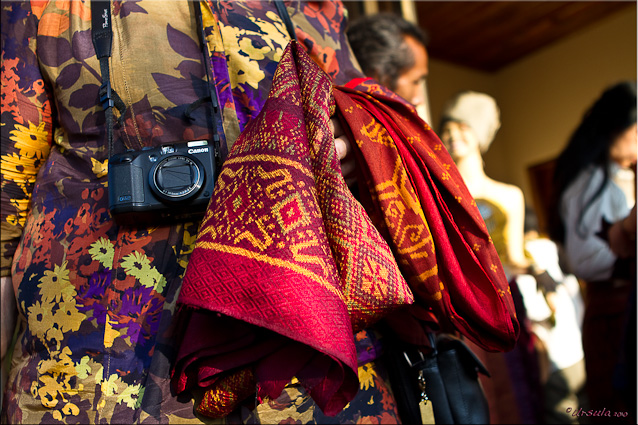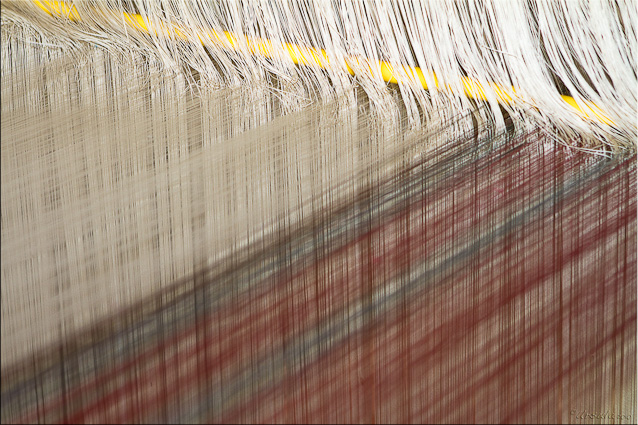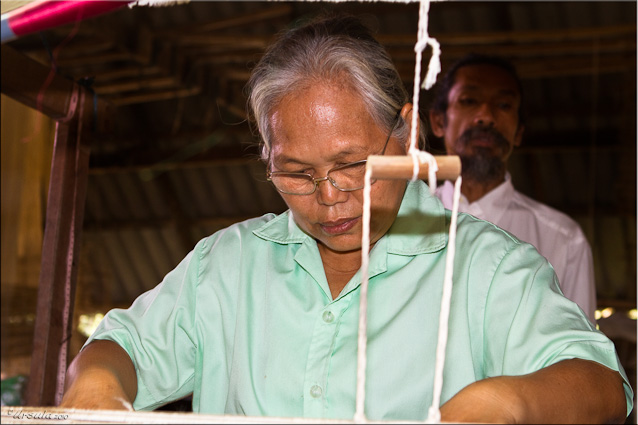
Colours, Layers and Textures: Shopping for Surin Silks ~ Ban Khwao Sinarin
Isn’t the English language wonderful? In the title “Weaving Communities” you probably read ‘weaving’ as an adjective – that is, communities that exist about or for weaving. But, weaving is more usually a verb: the art of forming something, (a fabric or a fabric item; a basket, a story, a rug, a community…) into a pattern by interlacing long threads passing in one direction with others at a right angle.

"Interlacing Threads at Right-Angles"
As I mentioned last week, I had the pleasure of visiting a number of villages in Surin; villages where both meanings are true. These are communities of weavers who produce beautiful textiles, and it is the act of producing these textiles that binds the community members together and allows the communities to grow and flourish while staying grounded in traditional values and practices.
Traditionally, women and girls produced silks and cottons for their household to use and to present to the local temple. In the old days, bells were attached to the moving parts of looms, so that local bachelors knew that ‘a modest, hardworking, diligent girl’ who might make a good wife, was hard at work. Every village in Surin has at least one loom, and although weaving usually only takes place in the free time when the rice harvest is in, most villages these days manage to produce silk for sale, to supplement their meagre cash-crop income.
Some communities, however, have taken the traditionally sought-after Surin silks to a whole new level. The first place we visited, Thasawang Silk Village, has been developed into an atelier of world standard by Ajarn Weeratham Trakulngernthai. A. Weeratham studied Arts before returning to the village to expand the silk production there to such an extent that he was chosen to design and produce the gift-silks for the international leaders visiting Thailand for APEC, 2003. He also produces much of the silk used by the Thai royal family.
This community of artists is involved in every aspect of silk-making. One purpose-build open-air building houses two-story looms operated by three or four workers.

Experience at the Head of the Two-Story Loom

Concentration ~ Tying off Threads

Young Women at the Sides

Young Woman in the Weave

Women at the Loom: Sitting at the Side and Standing Underneath

Silk Thread: Weft ~ Warp ~ Weave

Fine Weaving in Process

Golden Brocade Silk

Lunch Time! The Two-Story Looms at Rest...

Precious Gold Embroidery

Ajarn Weeratham Explaining Traditional Silk Patterns
Silk sales take place in expensive up-market shops, street stalls and in the downstairs open areas of village houses; anywhere that the community has a bit extra to sell and the buyers are ready.

Village Silk Seller, Thasawang

Young Girl at the Silk Markets

Silk Remnants are put to Colourful Use

Beetle-Nut Granny

Cotton Pha Thung (ผ้าถุง): Belt, Sarong, Head-dress, Baby Sling...

Silk Layers ~ Shop Front, Surin

Examining the Silks ~ Under the House ~ Ban Chok

Showing Off the Wares ~ Ban Chok

One of 700 Surin Silk Patterns
Surin boasts 700 traditional silk designs, many which were of Khmer origins. They involve complex weaving or dying processes, or both. Many villages produce “Mut Mee” or tie-dyed silk. The warp threads are wound onto a frame of the correct size, banana fibre is carefully tied around sections of thread according to a specific pattern, and then the whole frame is dipped in dye. When the dye is dry, the fibre is carefully cut away and the undyed spots are dabbed with other colours.

Mut Mee at Ban Khwao Sinarin

Producing Mut Mee Silk

Careful Mut-Mee Hands

Reeling the Silk
What impressed me, even more than the silks, however, was the way silk production, as a community cottage industry, drew the neighbourhoods together. Because it is such a labour-intensive and important industry, there is meaningful work for everyone, and the loom or looms become the village centre. At Ban Khwao Sinarin, when it was getting too dark for the carful attention that preparing and weaving Mut-Mee silks require, the traditional instruments came out and the singing and dancing started. The undisputed star of this impromptu “show” was the master-weaver’s eight-year-old daughter. One of my Thai companions said: “I am so glad that this is still happening in my country!” I completely understood her emotional pride.

Traditional Dancer ~ Khwao Sinarin

Toothless Smiles!

Khwao Sinarin Family

Dad and Daughter in the Dance

It was truly an enchanting experience, and a reminder of the true value of locally produced, hand-crafted products. ‘Till next time…



lovely
Wonderful set of photos and really interesting text.
Thanks, Gabe and Guava!
It’s always nice to know someone is out there. 🙂
what an amazing life(&)style these people lead and a reminder of the people who make this amazing silk…just lovely
really interested site and images. I wish you a nice week with
beautiful things, Dietmut
Hi Dietmut!
I’m so glad you stopped by. I hope you will pop in regularly. Have a good week yourself! 🙂
Cool, a really interesting post!…
[..] Today I was reading this fantastic blog post and I wanted to link to it. [..]…
Hi Ursula – thanks for your fascinating blog about Surin produced silk – and great photos. I’d love to visit those villages and find out more about silk production. Could you put me in touch with someone who could organise a visit for me? Best wishes and keep up the good work!
Hi Andy,
I’m glad you enjoyed the photos.
My visit was with the Thai Textile Society. They organised it through a Thai travel agency: Ubon Jinda Travel (+66 86 777 2118). Our guide, Pradit Deerorb (+66 83 364 1182) loves textiles and speaks good English. I can’t find email addresses for any of them, and as our visit was a long time ago, my information might be out of date.
But the places we visited are well known to any Surin agent (and are geo-tagged on my Flickr site) so any licensed agent in the area should be able to help you.
I hope this helps! Cheers.